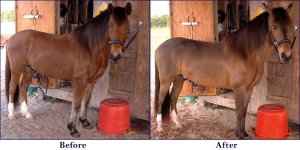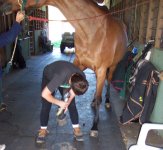♘امیرحسین♞
♘ مدیریت انجمن اسب ایران ♞
Ah, the joys of winter. The time of year when your sleek show horse turns into a yak. All that hair is great for protecting him if he lives outside and spends the winter just “being a horse”, but if he’s in work, or showing, it’s a major problem. Although some folks use stall lights to reduce or eliminate the growth of winter hair, by far the most common solution to the fuzzy horse in work problem is to lop that fur off.
If you’ve been around show or sport horses very long, chances are you’ve seen how good a professional clip job can look, and how bad an unskilled novice's efforts can turn out.
The best way to learn how to clip well is to watch an experienced clipper, then practice until you master the techniques. To help you shorten your learning curve, and make your horse look better while you learn, here are a few of the most important things to keep in mind.
Start with a clean horse. Precede your clipping efforts with a thorough bath using Quic Silver, Quic Color, or Quic Black. Scrub with a mitt or curry to work loose dirt and dander trapped in long winter hair. If the weather makes getting the horse wet inadvisable, Quic Groom waterless shampoo should be used instead.
Use the most powerful clippers you can handle. The stronger the motor, the faster the blades move. The faster the blades move, the better they'll cut through thick winter hair, and the fewer tracks they'll leave.
Make sure blades are sharp and well lubricated. Sharp, oiled blades require less power from the clipper motor, resulting in a better clip job. Plus the clippers run cooler, which both your hand and your horse will appreciate.
Slow down! Give the clippers time to do their work. A slower stroke will always yield a smoother job. The less powerful your clippers, the slower you will need to go. The blades should feel as though they are gliding through the hair, like the proverbial hot knife through butter.
2-Keep the blades parallel to the skin. Holding the blades at a steep angle to the skin is one of the most common mistakes novice clippers make. If the blades are parallel to the skin, especially on the large flat surfaces, they're much less likely to nick and gouge.
3-Clip against the lay of the hair. Pay attention to which way the hair is laying, as it can change at any time. In some places (flanks, armpits) there may be hairs that lay in several directions, meaning you’ll need to make two or three passes from different angles to get a good result.
Secure equine cooperation, one way or another. There’s no way to get show quality results if you’re clipping a moving target. Teach your horse to stand still, and accustom him to the clippers during regular grooming well before you try to clip. If you absolutely need to get him clipped before you have time to do the training, talk to your vet about sedating him. Make sure you do it far enough before a show that you don’t inadvertently violate the drug rules.
4-Restore color and moisture to the hair after clipping. When you're finished clipping, spray the whole horse with Quic Sheen. Its color-intensifying formula helps restore the rich natural color of your horse's hair. And its moisturizers alleviate the dry, rough feeling of skin and hair that often follow a body clip job.
If you’ve been around show or sport horses very long, chances are you’ve seen how good a professional clip job can look, and how bad an unskilled novice's efforts can turn out.
The best way to learn how to clip well is to watch an experienced clipper, then practice until you master the techniques. To help you shorten your learning curve, and make your horse look better while you learn, here are a few of the most important things to keep in mind.
Start with a clean horse. Precede your clipping efforts with a thorough bath using Quic Silver, Quic Color, or Quic Black. Scrub with a mitt or curry to work loose dirt and dander trapped in long winter hair. If the weather makes getting the horse wet inadvisable, Quic Groom waterless shampoo should be used instead.
Use the most powerful clippers you can handle. The stronger the motor, the faster the blades move. The faster the blades move, the better they'll cut through thick winter hair, and the fewer tracks they'll leave.
Make sure blades are sharp and well lubricated. Sharp, oiled blades require less power from the clipper motor, resulting in a better clip job. Plus the clippers run cooler, which both your hand and your horse will appreciate.
Slow down! Give the clippers time to do their work. A slower stroke will always yield a smoother job. The less powerful your clippers, the slower you will need to go. The blades should feel as though they are gliding through the hair, like the proverbial hot knife through butter.
2-Keep the blades parallel to the skin. Holding the blades at a steep angle to the skin is one of the most common mistakes novice clippers make. If the blades are parallel to the skin, especially on the large flat surfaces, they're much less likely to nick and gouge.
3-Clip against the lay of the hair. Pay attention to which way the hair is laying, as it can change at any time. In some places (flanks, armpits) there may be hairs that lay in several directions, meaning you’ll need to make two or three passes from different angles to get a good result.
Secure equine cooperation, one way or another. There’s no way to get show quality results if you’re clipping a moving target. Teach your horse to stand still, and accustom him to the clippers during regular grooming well before you try to clip. If you absolutely need to get him clipped before you have time to do the training, talk to your vet about sedating him. Make sure you do it far enough before a show that you don’t inadvertently violate the drug rules.
4-Restore color and moisture to the hair after clipping. When you're finished clipping, spray the whole horse with Quic Sheen. Its color-intensifying formula helps restore the rich natural color of your horse's hair. And its moisturizers alleviate the dry, rough feeling of skin and hair that often follow a body clip job.




